#Notable Deaths in September 2023
Explore tagged Tumblr posts
Text

TERRY KIRKMAN (1939-Died September 23rd 2023,at 83). American musician and songwriter best known as a vocalist for the pop group the Association and the writer of several of the band's hit songs such as "Cherish", "Everything That Touches You", and "Six Man Band". As a member of the Association, he was inducted into the Vocal Group Hall of Fame in 2003.Terry Kirkman - Wikipedia
#Terry Kirkman#American Musicians#Musicians#The Association#Notable Deaths in September 2023#Notable Deaths in 2023
45 notes
·
View notes
Text
why does aniplex want mahoyo to fail
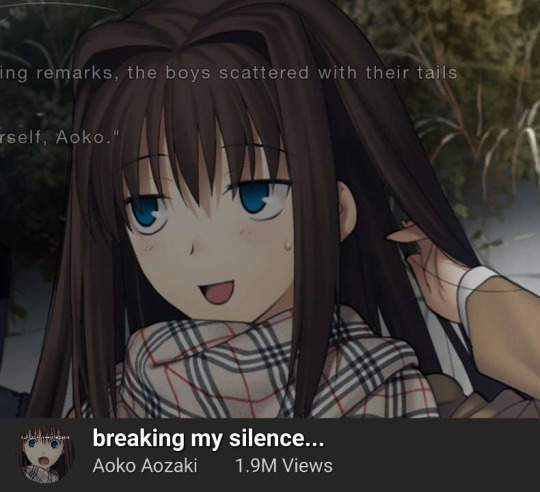
I love visual novels. being a long time fate/stay night fan and only having heard of mahoyo from hushed whispers about its cinematography, I was super invested when it was announced to be coming to the west and I could finally play an official version of it.
however, a lot of people interested in type-moon works had never heard of mahoyo, let alone it getting an official english translation. but how? aniplex is publishing the game and they're one of the largest anime distributors in the world.
with the console release of mahoyo being almost exactly a year ago and the steam release being just 10 days away, I want to look over some of aniplex USA's bizarre and nonexistent marketing for one of my favorite visual novels.
let's clear up a few things, first.
mahoyo is the shortened form of mahoutsukai no yoru (not to be confused with mahoutsukai no yome, i.e. the ancient magus bride), which has been localized as witch on the holy night. mahoyo was a linear non-eroge visual novel released by type-moon in 2012, being one of the first scripts kinoko nasu (co-founder of type-moon) wrote back in 1996 and adapted into a VN many, many years later.
in April of 2022, a console remaster (switch, playstation 4) was announced with HD assets and voice acting, to be published by aniplex. notably, this console release would contain an english translation and was later confirmed in June to be sold in the west via online retailers. this was huge news, as this meant mahoyo would be the first type-moon visual novel (not including gameplay-oriented titles like fate/extella or fate/grand order) to be officially released in the west, as despite numerous fan translations, their more recognizable visual novels tsukihime and fate/stay night still had not received a localization.
type-moon is the developer behind mahoyo and aniplex is the publisher, meaning that type-moon made the game and aniplex is in charge of distributing (and marketing) the game worldwide.
timeline:
April 11 2022: Mahoyo rerelease announced for consoles (Switch & PlayStation 4), including English translation
July 4 2022: Aniplex confirms Mahoyo will be available to the West, localized under the name Witch on the Holy Night
October 14 2022: 2nd trailer released, more voice actor info announced
November 3 2022: physical pre-orders launched, demo version available
November 18 2022: Aniplex attends Anime NYC with Mahoyo
December 7 2022: Mahoyo released digitally on Switch / PlayStation 4 (Dec 8th in Japan, Dec 7th in America)
December 12 2022: Mahoyo reaches 110k units sold worldwide
January 27 2023: Mahoyo physicals release
July 5 2023: Mahoyo reaches 150k units sold worldwide
September 10 2023: Mahoyo announced for Steam via a now unlisted Aniplex livestream
December 13 2023: Mahoyo will be released on Steam (Dec 14th in Japan, Dec 13th in America)
some of the dates might be a little fuzzy, especially the release dates, as some sources go by japanese time and some go by american timezones, so just be aware of that.
now, let's talk a bit about mahoyo itself.
mahoyo is a masterpiece. it's a niche game not meant for everyone. its cinematography is top notch among visual novels. its writing style can be off-putting to people who want faster-paced stories. it's one of my most beloved visual novels I've ever played, and I've been in this field for almost a decade and have played well over 100 VNs.


mahoyo is a completely linear visual novel—meaning it has no choices or gameplay—that follows aoko, a high schooler mage trying to balance her perfect school president facade with her secret life as a mage, something she has to keep secret at the risk of death. this is one of the lesser known type-moon works but it's well beloved because of the care put into it.
if you've ever heard someone talk about it, it's almost impossible for them to not mention the visuals. mahoyo is one of the most visually impressive visual novels I've ever seen, with its inspired use of artwork and in-game animations. I cannot recommend this VN enough if you like modern fantasy and don't mind linear VNs.
before we dive into aniplex USA's marketing, I want to clarify a few marketing terms for people who don't market visual novels as a job. marketing is not just advertising—it's everything related to how a product communicates with potential users, including its branding, its packaging, its everything. when marketing a game, you have several different avenues: social media, press & influencers, trailers, store pages, and more.
today I want to show you how, based off what I have researched after a long, manic day, aniplex USA has failed mahoyo on all of these accounts.
so let's go back to its western release.
mahoyo has a few official english channels:
website
twitter
facebook
aniplex also has an official english twitter with almost 500k followers where they shared mahoyo very rarely—only 9 tweets about the game ever.
well, surely their other pages are more maintained right—


both accounts stopped posting July 10th/11th, with their last post being about mahoyo going on sale on consoles. let's look at their posts prior to this, though, starting with the twitter.
we can see that the twitter account was made in december of 2022. if we scroll down far enough (it's not hard, given they only have 33 tweets), we can see that their first tweet was on december 6th 2022:
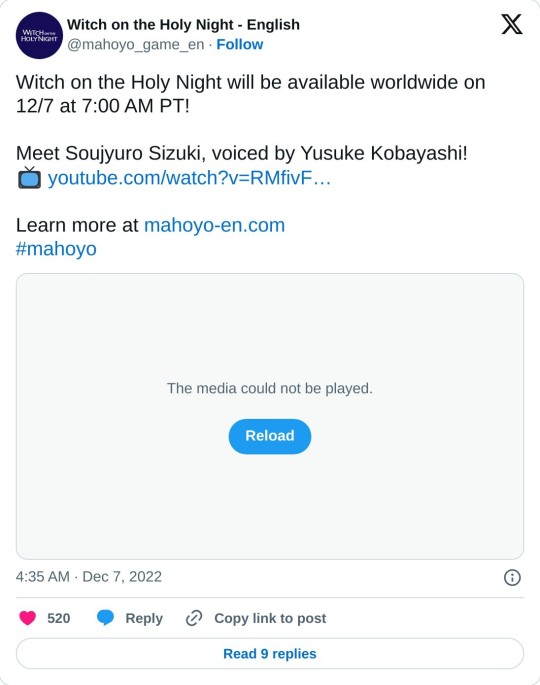
let's go back to our timeline. can you tell me when mahoyo's remaster released digitally?
yes they made both of the english mahoyo social media accounts the day before the game launched
we can very easily add up the entire social media posts for the game thus far:
mahoyo english twitter - 30 tweets and 3 retweets
mahoyo english facebook - 27 posts
aniplex english twitter - 9 tweets
aniplex english facebook - 2 posts
no other english social media accounts were tied to the website, so these are the only ones I looked at. this means in total, there were only 68 social media posts for the console release of mahoyo by the publisher for english audiences.
but what about the steam release? after the game sold over 150k+ units on consoles, surely aniplex was ready to market it a bit more for pc users—
neither account has made a post about the upcoming steam release.
if we look at the twitter, they have 3 tweets since July that do talk about the upcoming steam release- however, these are retweets from the japanese mahoyo account.
we know that this twitter and this facebook account are the official social media for mahoyo as they're linked on the website, so they're definitely meant to be followed for game updates in the west. well, maybe the english aniplex twitter has posted about it—
none of the english aniplex or mahoyo accounts have made a single post about the steam release
that's right, the social media posts I counted above are the only posts for mahoyo on their english accounts, all dating back before the steam release was announced. since then, they have not made a single original post even mentioning the steam release.
meanwhile, the japanese mahoyo twitter has been hustling hard to promote the upcoming steam release—reposting trailers, character bios, and more almost every day with pretty good numbers.

in fact, the japanese mahoyo twitter did such a good job at marketing it that the aniplex USA twitter never mentioned the english mahoyo twiter, instead only @ ing the japanese one in tweets (despite the english one being linked on the website).

why they even bothered making social media accounts and then not running them despite being one of the largest anime distributors in the world I have no clue.
well, maybe they didn't need to rely on social media presence. maybe they were going for the in-person approach and marketing it at conventions.
mahoyo had basically no anime convention presence
the only reference I can find to aniplex notably promoting mahoyo at any western convention is this tweet of them at anime NYC. from someone who was at anime NYC, I've been told that they pushed the game heavily at their booth with TV screens promoting the game.

however, anime NYC is only one anime convention. you cannot hope to sell a game by just attending one anime convention. mahoyo might have had a presence at other american conventions, but I'm unable to find any images or news about this.
maybe they don't understand type-moon
aniplex is the publisher for fate/grand order, one of the most successful mobile games ever created. they're also the distributor for a majority of type-moon related anime, ranging from fate to garden of sinners to side series. aniplex's marketing team should have lots of experience with type-moon properties.
maybe it was promoted in other aniplex titles
I was also unable to find a news post in fate/grand order related to mahoyo's release, despite news posts for other type-moon series (namely fate but also things like melty blood) getting news posts in fate/grand order. I might've missed the news posts when looking back through FGO but I don't believe there was one.
maybe it sold well in other regions but not western ones
(I'm going to be referring only to the console release for these stats, keep in mind)
mahoyo released December 7th/8th 2022 with an english, japanese, simplified chinese, and traditional chinese translations. at the end of the release week, mahoyo's japanese twitter announced the game had sold 110k copies worldwide and famitsu reported that 66,344 of these units were sold in japan. this means we have around 43k units unaccounted for.
we know the game was available in english, japanese, and chinese languages but we don't know what regions. mainland china has a very large visual novel playerbase (I say this as someone who sells visual novels), which means if it were sold there then it's easy to say that a big chunk of that 43k units could be attributed to them—this also means it would be easy to believe that aniplex saw mahoyo selling worse in western countries and took this as a sign to not promote the game any more there.
but was it ever sold in mainland china? from what I could tell—no.
looking at pricing charts for the nintendo eshop and the playstation store, china is not listed on either. furthermore, searching the game's chinese title on the chinese playstation store does not bring back any results. it looks like the only predominantly chinese-speaking regions that were able to buy it are hong kong, taiwan and possibly singapore (the playstation store page for it doesn't look like it's available for purchase anymore).
so what does this tell us?
without any other numbers it's hard to tell how many of the 43k launch week sales came from english-speaking players, but even if we conservatively say that only around 20k of the 110k launch week units were from western countries, that's still almost a million in revenue (and remember, the physical limited edition of the game was available in english for $60, which is $20 more than the digital base version).
maybe the store page is so good they don't need to market it
here's a little secret: store pages matter a lot more than you'd think. there are entire job positions dedicated to tailoring store pages (like a steam game page) to make it perfect for the game's target audience. there's a science to it that includes the artwork, descriptions, tags, screenshots, and more.
let's see what aniplex did for the steam page of mahoyo.
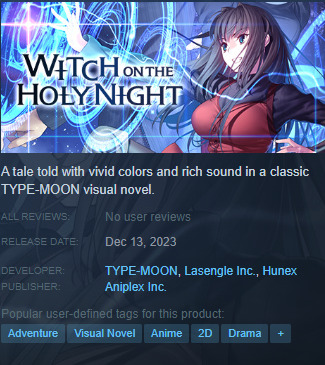
A tale told with vivid colors and rich sound in a classic TYPE-MOON visual novel.
I don't know how to describe this short description charitably other than to say it sounds like a person who's never heard of a visual novel has been tasked with describing a visual novel.
this tells me nothing about the game other than it's a visual novel. I hope you know what type-moon is, because if you don't then you've learned nothing else from this. alright, well, let's look at the screenshots—
there's only 1.
currently as of writing this, there's 10 images uploaded as screenshots (no trailers, they keep adding and removing the trailers for some reason). 9 of these images are just the full artworks from the game while 1 is an actual screenshot.
I really hate this, as you're not actually shown what the game looks like unless you look at the very last screenshot. this will absolutely lead to some people not understanding what they're getting into. what's worse is that some of these CGs are spoilers, especially one in particular featuring my wife touko.
why are we spoiling people instead of showing them screenshots? why not show people what mahoyo actually looks like??
there's also absolutely no use of the announcements section on steam. each game on steam can post announcements related to the game, including upcoming releases, new updates, and more. it's customary to post a steam announcement when a game has a release date announcement. mahoyo's steam page has none.
well they probably released the trailers in english for hype
I wish I had that much hope.
on mahoyo's english website, all of the videos listed are from the official type-moon youtube, which is their japanese channel. type-moon went through the effort to translate these videos. aniplex didn't upload these to their own youtube, where they already upload everything related to the fateverse and nasuverse.
searching up witch on the holy night brings up no results for the trailer—aniplex never uploaded the trailer to their channel.
maybe they got influencers to play it
according to steamdb, the max amount of viewers mahoyo streams have had on twitch was 71 viewers.
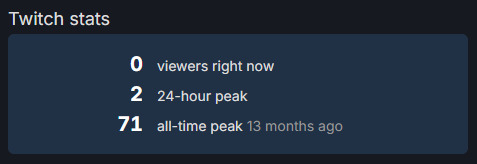
furthermore, if we check twitch and look for vods attached to mahoyo, we only find 4 videos total, all of which were posted in the past week. it looks like they didn't even reach out to streamers to play the console release, much less pay them.
over on the press side, it does look like they reached out to at least a few reviewers. for example, on the review by noisy pixel, they clarify that a review copy was provided by the publisher for review purposes. we can add that to the bare minimum of marketing—reaching out to press.
however, they did get for some other influencers to share the game! ...twitter game sale influencers, that is.

there's actually a lot more of these types of tweets for mahoyo than I was expecting when I searched it on twitter. as a friend pointed out, just because it says "#ad" doesn't necessarily mean these were paid for by aniplex—a lot of these links look to be referrals, which means they're getting a cut of any purchases.
let's recap
mahoyo released over 110k copies in the launch week for it's worldwide console release despite very, very limited marketing efforts from its publisher aniplex. now that the game has proven it can sell very well despite being a lesser known linear visual novel, aniplex has done no marketing for the steam release- no tweets, no influencer outreach, no localization of trailers, no announcements via steam, nothing.
so why?
why does aniplex want mahoyo to fail?
even after all of this, I still do not know why. to me, it's clear that the marketing team at aniplex were (most likely) given no budget for this game and just couldn't do anything with it, deciding to spend what little money they had on press outreach and an anime NYC booth.
but why? why didn't aniplex give them a budget, even a small one? why was their budget so tiny they couldn't even afford to tweet? to RT more posts from the japanese twitter? to share the already translated trailers to their own accounts?
I've heard a few excuses like "type-moon hates western fans and probably caused it" but this doesn't make any sense either. why would you authorize a translation of your game and allow your publisher to sell the game overseas but specifically make them not market the game (and what publisher would agree to that)? I've even heard excuses like "they just forgot it was coming out", to which I ask "how does an entire marketing team (a company the size of aniplex absolutely has a team(s) for marketing and not a singular person) forget a release for a game that's already sold over 150k copies?". the only excuse I've seen that I somewhat buy is that they did not have much faith in the game and relied almost entirely on fans doing word of mouth marketing for the game.
I don't think we'll ever get an answer. while I do believe the marketing team at aniplex was most likely given no budget for mahoyo, it still begs the question of why. why did someone at aniplex not want to give mahoyo a marketing budget? why are the japanese accounts for mahoyo and type-moon the only ones doing the marketing?

I hope the information I've provided here is accurate—if it's not, I'll try to update with corrections. I don't want this piece to cast hate towards the staff at aniplex or anyone involved with this projects, I'm just trying to assemble the pieces on what feels like a game being left to word of mouth. I've tried to include as many links to my sources as I could so you could come to your own judgements about what has happened regarding mahoyo's worldwide release.
mahoyo is a visual novel that's dear to me and will absolutely sell well on steam—with an estimated 50-80k wishlists, it's going to have a solid launch despite the zero marketing for its steam release. if you love other type-moon works or want to see an absolutely visually stunning visual novel, please check it out.
— arimia
#visual novel#visual novels#mahoyo#mahoutsukai no yoru#witch on the holy night#mahoyosweep#type-moon#visual novel game#anyway please play mahoyo#my articles
494 notes
·
View notes
Text
TVT Adminpocalypse
TW: transphobia, acephobia, bullying, suicide
Hey, for those of you not aware, TV Tropes has gotten very bad in the last six or so months. I'll do my best to give a short summary.
2022: Fighteer, a mod notorious for using his post to bully others, takes a self-imposed leave after several users call him out on this pattern of behavior. Due to user backlash at general moderator behavior, a mod code of conduct was established. While self-enforced, the moderator discussion thread existed, in part, to discuss future incidents.
September 2023: User AgProv is suspended for calling Dylan Mulvaney a man. In his appeal, he tries to get around the issue by using they/them pronouns. Though Mulvaney uses both she/her and they/them, as this appeal was clearly done in bad faith, AgProv had been bounced from the site. A few hours later, however, Kory, a site programmer, unilaterally overrides the bounce on behalf of otherwise non-present site owners, citing he was a productive user with several edits. When called out on this, Kory doubled down, using thumps and suspensions to shut down conversation. Notably, AgProv was later suspended for messy editing, but to this day has not needed to appeal his transphobia suspension through the typical process.
youtube
Later that month: Fighteer is asked back by the admins, citing a need for manpower. Fighteer's "apology" amounts to being burnt out and justifying his meanness as being an "equal opportunity" bad cop. He promises to step back from areas of the site where he'd been an issue previously. This does not last. By the end of this one-two punch, the moderator discussion thread is reworked into a narrow policy clarification thread with issues of misconduct being exclusively handled by emailing the admins.
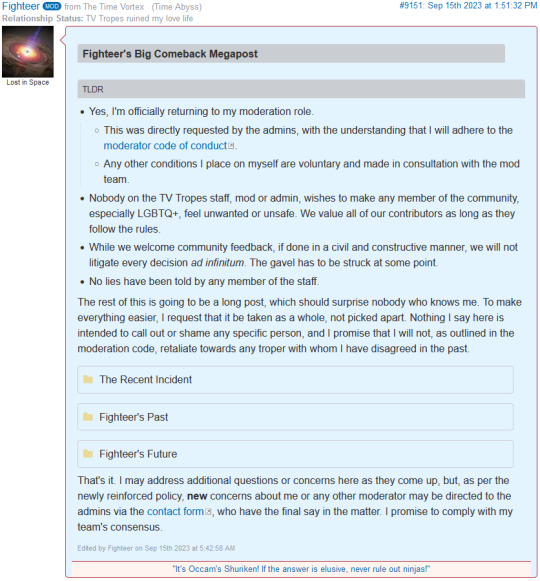
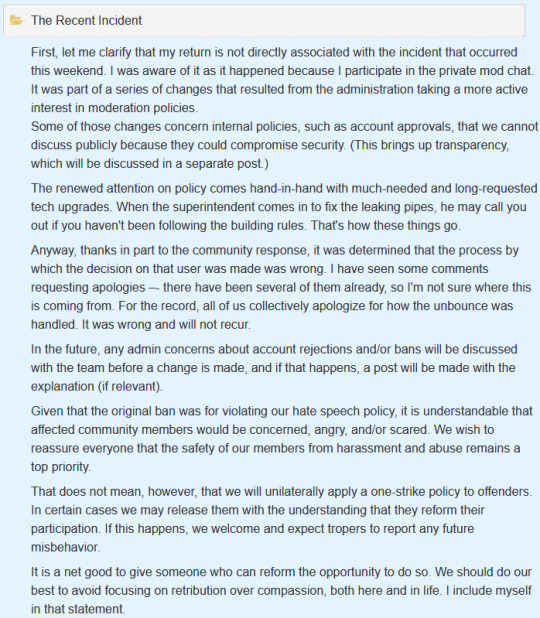
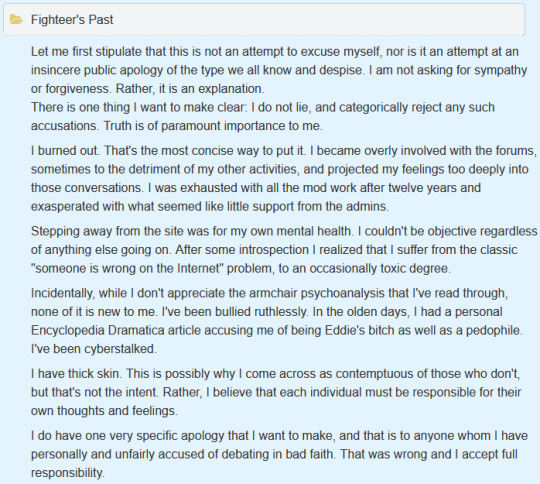
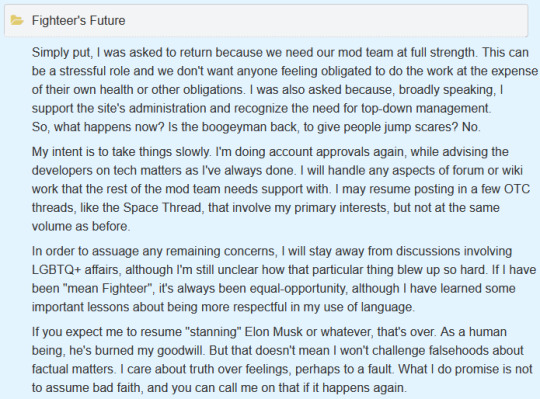
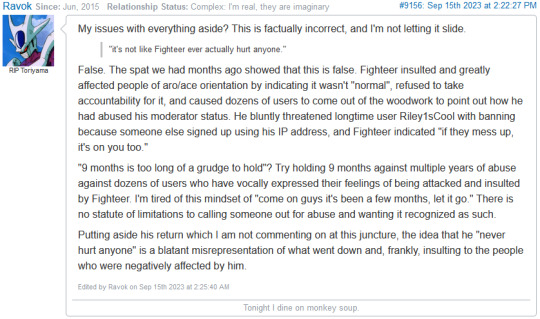
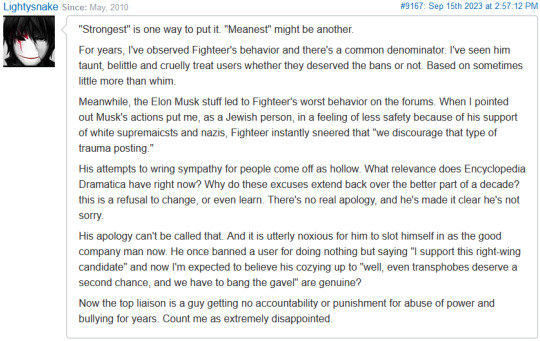
Past seven days: Fighteer makes a post in the social media thread stating that people threatening suicide over a possible TikTok ban should just do it. In another post, he considered this an act of terrorism. These post were thumps, but no other visible disciplinary action was taken. This is despite the US Politics thread being closed for celebrating the death of Henry Kissinger. Again, attempts at discussion were swiftly shut down. Notably, Kory all but stated that Fighteer, despite all the issues, was worth having as a mod.
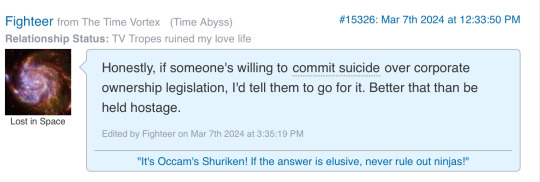


So for anyone reading, consider spreading the word. While that alone won't fix the underlying problem of private tech companies pushing for content at the expense of user experience, if enough people, and especially, advertisers, catch wind of this, it may create enough of a PR disaster where the administrators will change course rather than quintuple down. For anyone who, understandably, does not wish to do that, then please, if you haven't already, get an ad blocker and make sure it's on for that site.
Thanks!
147 notes
·
View notes
Text
Well. My curiosity about the post-S2 state of the OFMD fandom has been piqued - though much later and not at all for the reasons I thought it would be before watching the season - so I'm finally going to do that fanfic statistics follow up I planned almost a year ago.
Links to my first fanfic statistics from January 2023 (first 10 months of the fandom) and hiatus check in September 2023 (8 months of "deep hiatus"). This follow up adds the month of S2 lead up + airing and the 8 months and change immediately following it, which should by all rights include the traditional fic boosts of Kinktober and NaNoWriMo. So.
My hiatus check fic count was 23,187. Today's is 32,998 total fics in the Our Flag Means Death tag.
Right off the bat, this is interesting. 9,811 fics have been added. Which doesn't sound bad except in the deep hiatus timeframe - slightly shorter window, much further away from new content - the fandom added 11,115 fics. There's definitely factors at play like fandoms naturally losing people and creative energy over time and the series cancellation news, but I said back last year that it felt like the fandom activity didn't really spike with new content, and this tracks with that.
Character Tagging:
Edward Teach - 24,411 fics, 74.0% of the total
Stede Bonnet - 22,696 fics, 68.8% of the total
Izzy Hands - 16,627 fics, 50.4% of the total
Lucius Spriggs - 8,228 fics, 25.0% of the total
Jim Jimenez - 5,193 fics, 15.7% of the total
Frenchie - 4,167 fics, 12.6% of the total
Oluwande - 4,165 fics, 12.6% of the total
Percentage deviation is following the same trend as last time, with Izzy appearing in a slightly higher percentage of fics and everyone else in a slightly lower, only the actual "interest" change is even smaller this time - everyone here including Izzy is within at least 2% of where they were last check except Edward who dropped a whole -2.7% overall when he was "only" tagged in 6,638 (67.7%) of the new fics. How will people cope. Jim dropped the least - only -0.3% overall. Anyway interesting news Frenchie has gained prominence and overtaken Oluwande for 6th place by a whole 2 fics, which I enjoy because he was my Revenge crew fave.
Shipping: The Main Couple Math
BlackBonnet is tagged on 20,282 OFMD fics, making it 61.5% of the fandom. Running the otp:true search says that now 13,597 fics and 41.2% of all OFMD content is BlackBonnet with no side pairings at all.
Taking SteddyHands into account - 1,240 of those fics are also tagged with SteddyHands, making it 6.1% of BlackBonnet and (if you exclude them) putting BlackBonnet at 19,042 fics and 57.7% of the fandom.
7,190 fics under the Izzy Hands character tag are tagged BlackBonnet - which is 43.2% of all his tagged fics, and 21.8% of all fics. SteddyHands is also tagged on 1,150 of those, so excluding it brings us to 36.3% of “Israel Hands” fics / 18.3% of OFMD fics are tagged with BlackBonnet + “Israel Hands” and NOT SteddyHands.
BlackBonnet continues to leave notably more of the pie than last time available for other ships and characters, which is still objectively a good thing even for most people who love the ship. It's not hurting for attention, but it's getting closer to the high end of reasonable dominance vs the level where authors writing side character ships are legitimately hard to find. A healthy fandom will often have the main pairing below 50%. SteddyHands is still super niche in comparison.
Shipping: Everyone Else
Edward/Izzy - 3,982 under "Israel Hands", 4,260 (12.9%) total
Edward/Izzy (SteddyHands excluded) - 2,826 under "Israel Hands", 3,017 (9.1%) total
Edward/Stede/Izzy - 2,567 under "Israel Hands", 2,806 (8.5%) total
Stede/Izzy - 2,229 under "Israel Hands", 2,404 (7.3%) total
Stede/Izzy (SteddyHands excluded) - 1,167 under "Israel Hands", 1,262 (3.8%) total
Lucius/Izzy - 1,535 under "Israel Hands", 1,705 (5.2%) total
And in non-Izzy ships, Stizzy did make notable gains post-S2 and has passed up Black Pete/Lucius and Oluwande/Jim in total fics for the first time (though only with SteddyHands tagged fics included in the count) - likely due to a combination of canon decisions made in S2.
Black Pete/Lucius - 2,302 (7.0%) fics. 72.7% of these are also tagged BlackBonnet. Excluding BlackBonnet leaves 628 (1.9%) fics.
Oluwande/Jim - 1,933 (5.9%) fics. 68.2% of these are also tagged BlackBonnet. Running otp:true leaves 360 (1.1%) fics.
BlackHands has actually gone down the slightest bit by overall percentage and brought SteddyHands down with it, though it is impossible to accurately track SteddyHands fics that are tagged as component pairings alone vs the throuple tag. This makes sense with how Izzy fans have branched further into negligible Izzy ships such as Izzy/Frenchie in the wake of S2. Both non-Izzy ships also went down, but this is probably related to both being more heavily featured in S1 and still mostly riding those numbers (especially Oluwande/Jim who canonically broke up in S2).
Honestly I think I'm both surprised it's not more active with the well timed new content and surprised that everything is still so consistent. It confirms some minor suspected trends, but mostly just looks like an even less dramatic deep hiatus update.
Oh and also slight disclaimer - I have exactly one person muted on AO3 and I think they've written for OFMD and it would have excluded their fics, so my sourced counts may be off by extremely small numbers contributed by one author? Idk exactly how AO3 handles that in the fic search interface.
#our flag means death#ao3#statistics are good and fun#izzy hands ofmd#stede bonnet ofmd#blackbeard ofmd#ofmd meta#shipping#my meta#ladyluscinia
41 notes
·
View notes
Text
The US is experiencing its largest summer Covid wave in at least two years - Published Aug 16, 2024
It may be time to dust off the face masks and air purifiers.
The US is in the midst of a significant Covid-19 wave, with viral activity levels in wastewater the highest they’ve been for a summer surge since July 2022, according to the US Centers for Disease Control and Prevention’s wastewater dashboard.
The CDC’s measure of national Covid viral activity in wastewater rose to 8.82 on August 10 – falling shy of a peak of 9.56 in July 2022. The CDC says the most recent data is incomplete and may change. Before it started rising again in May, it was at 1.36.
“Currently, the COVID-19 wastewater viral activity level is very high nationally, with the highest levels in the Western US region,” Dr. Jonathan Yoder, deputy director of the CDC’s Wastewater Surveillance Program, said in an email. “This year’s COVID-19 wave is coming earlier than last year, which occurred in late August/early September.”
Emergency room visits, hospitalizations and deaths are also ticking up, although not to the same extent as infections, according to the CDC’s Covid dashboard. As of the end of July, the CDC’s dashboard shows about 4 are being hospitalized for Covid for every 100,000 people in a given area, up from a low in May of about one Covid hospitalization for every 100,000 people – the lowest level since the pandemic began.
The CDC’s wastewater data closely aligns with what they’re seeing at the nationwide WastewaterSCAN network, too.
“This is a very significant surge. The levels are very high. They’re the highest we’ve ever seen during a summer wave,” said Dr. Marlene Wolfe, an assistant professor of environmental health and public health at Emory University and a program director for WastewaterSCAN. “We’re detecting SARS-CoV-2 in 100 percent of our samples across the country right now.”
WastewaterSCAN also began monitoring in early 2022 and the number of sites that it monitors has changed over time.
“Despite these changes, it’s notable that levels right now for WastewaterSCAN are much higher than previous summer peaks and yet still below the average concentrations at the height of the winter peaks in 2023, 2022, and 2021,” said Dr. Alexandria Boehm, professor of civil and environmental engineering at Stanford University and program director for WastewaterSCAN.
Health officials no longer track the coronavirus as closely as they did during the public health emergency, and there are no longer reliable estimates of daily or weekly new infections in the US. Instead, the nation is largely relying on wastewater levels to follow numbers of new cases.
Wolfe says the amount of virus in wastewater doesn’t precisely correlate to numbers of infections. That’s because there are a host of things that can influence how much virus is in wastewater – including how much water is flowing through the sewage system when sampling takes place, as well as how much virus people may be shedding with a given variant. Despite these variables, she says sampling over time has shown there is a strong relationship between the number of people infected in a given area and the amount of virus in local wastewater.
“We can’t say exactly how many more cases that may be compared to previous years, because some of those changes might have happened in the virus in the areas that we’re measuring,” she said.
The rise in cases is being driven by waning immunity in the population and a trio of new variants that have drifted enough from their parent virus, JN.1, to escape the ability of our antibodies to quickly neutralize them.
Cases are also climbing just as children head back to classrooms in many parts of the US, giving the infection plenty of opportunity to spread.
It’s not clear when this surge will peak and start to taper off.
“Here in Houston, Texas, wastewater numbers are still high and not declining. They have reached a plateau at a high level for several weeks,” said Dr. Peter Hotez, an infectious disease expert who is director of the Center for Vaccine Development at Texas Children’s Hospital.
The surge of cases has also come ahead of the availability of an updated Covid-19 vaccine designed to better protect against the new variants, which could help slow the spread of the virus.
“It’s a bit disappointing that these are not available now, as Covid is surging,” Hotez said.
The US Food and Drug Administration has not yet approved the latest tweaks to the Covid-19 vaccines, but experts say they’ve heard that updated shots from Pfizer, Moderna and Novavax should be ready in the coming weeks.
In June, the FDA, following its normal process of reevaluating the need for changes to the Covid vaccines, directed manufacturers to update their shots for the fall to better match the variants that were making people sick.
“We keep hearing rumors that it will be here by the end of September, so we shouldn’t have to wait too long,” said Dr. William Schaffner, an infectious disease expert at Vanderbilt University.
The best thing people can do as far as their own personal risk is to get that vaccine when it does become available, Hotez said.
“Next, of course, is a good N95 or KN95 mask when you are in crowded indoor areas,” Hotez said, and seek out the antiviral medication Paxlovid if you test positive. For that reason, it’s also a good idea to stock up on Covid-19 tests to identify whether any coughs or runny noses are being caused by the coronavirus.
#covid#mask up#pandemic#covid 19#coronavirus#wear a mask#sars cov 2#still coviding#public health#wear a respirator
15 notes
·
View notes
Text
Love of My Life
LOML closes out Harry's House, it's a sad song about realising someone is the love of his life after he had lost them. Harry has spoken about an albums start and end, Harry's House starts with Sushi, imploring his muse to let love in and asking himself if just a taste of love is enough. LOML is about loss of that person and realisation that they were the love of his life. To Zane Lowe Harry said:
"Love of my life, I’ve always wanted to write a song about like home and loving England and all that kind of stuff. And it’s always kinda hard to do without being like ‘went to the chippy and I did this thing’ and to me Love of My Life was the most terrifying song for a long time because it is so bare, it's so sparse." He went on to say: "And in the spirit of what Harry's House is about, I think it started as an idea that was very literal, on the nose, [...] As I started making the album it wasn't about the geographical location it was much more of an internal thing."
So, what he said was that it is about his home and England is a metaphor. Home is common theme in Harry's work, most notably in Sweet Creature but even in 1D it has meant more than a place to him. The notebook also has a quote 'your mother is my home'. Taylor has also used home or homeland to refer to Harry, WomanExile has a great post on their usage of home as a metaphor for each other.

The Lyric Video has roses, which Harry and Taylor Swift also use to refer to each other:
Since 1989, all rose and thorn lyrics are about Harry
Harry 's rose Tattoo is from 11 September 2013, when they started dating again after the VMAs.
Roses have been in videos, outfits, social media posts about each other, a list is here.
Timeline
In the NY ONO show Harry said he wrote it in Rob Stringers' (Sony CEO) house and that the phone ringing in it is his. As it Was was recorded in the same session, and in part, has a similar meaning. This places it in the first half of 2021. After the rest of the album, California. Also after Folk/evermore which are about communicating and endings respectively. Harry had seen Taylor in March at the 2021 Grammy's. At the time it was written Taylor was still dating Joe. Harry had been dating Olivia for a few months.
California in particular refers to 'summers death left to breathe' indicating that there may have been an ending of sorts in 2020 before he returned to England and drove to Italy over the time Folklore was released.
Though not lyrically addressed, to me LOML is a 'yes' to Question..?'s "Did you realize out of time, she was on your mind?" Question was written in the same time period, after the Grammy's interaction but was released 6 months later.
Tracklisting, release and length
Love of My Life is Harry's only track 13, Taylor's number. It was released on her birthday. It is 3:12 long, or March, 31 2012 - the date they met.
Live shows
Harry said to Zane Lowe he thought he would close the show with it. And he did up until March 25 2023 when it was replaced by Fine Line in the last leg. Later that same week Taylor Swift replaced Invisible String with The 1 and announced her split from Joe Alwyn. It only returned for the 3 Wembley shows.
It was missing for 30 shows and is one of the least played Harry’s House songs, only above Boyfriends and Grapejuice which was added for the last leg.
Lyrics
Baby, you were the love of my life, woah Maybe you don't know what's lost 'til you find it
The first verse is a turn on the phrase “you don’t know what you’ve got till it’s gone” he reconnected with his love and found she is the 1 but it is past tense, he still lost her. This is similar to the Clean secret message, which also appeared in the OOTW video “She lost him but she found herself and somehow that was everything.” And the cyclical nature of this relationship.
Take a walk on Sunday through the afternoon We can always find somethin' for us to do We don't really like what's on the news, but it's on all the time
The second verse to me is remembering good times with this person, when he felt at home, with shared experiences and comfort. The Central Park walk with Taylor was on a Sunday.
I take you with me every time I go away In a hotel, usin' someone else's name I remember back at Jonny's place, it's not the same anymore
To me, I take you with me everytime I go away refers to what Harry said about an internal feeling, no matter where he is in the world his love is ever-present even when they are not.
In the Dublin show on the 22nd June 2023 Harry confirmed this refers to his childhood friend is Jonathan Harvey. This speaks to Harry’s concept of home as the feeling that you are loved and belong. To me this reference is to when Harry took Taylor on a tour of his home in England, to the lakes, where he grew up and she may have met Jonny in 2012. She said that was her best birthday, sharing his home with her was important to him. To me, this line means their relationship is different now to it was then. As it was is also similar with with an external view of how others would see them and their place in life.
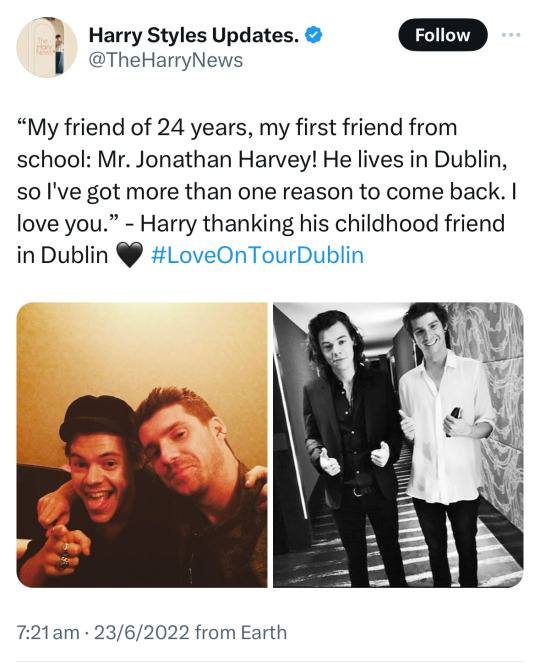

It's unfortunate, ooh Just coordinates, ooh
It’s unfortunate, just coordinates sounds to me like he’s reflecting on how they got from the Lakes trip to their current state. This applies to his feelings about love and home. The impact touring has had on his life, what is home and his relationships.
I don't know you half as well as all my friends I won't pretend that I've been doin' everything I can To get to know your creases and your ends Are they the same?
Knowing his love is a theme, in Sunflower Harry sang “Let me inside, I wanna get to know you” and in Fine Line “Spreading you open Is the only way of knowing you” to explore the idea of intimacy co-existing with distance with the same person.
He also sings about not knowing his love in Trouble “And I don’t even know you / But I feel like I do sometimes”. Interestingly in If I could fly he feels like she knows him “Now you know me / for you eyes only”.
The “are they the same” speaks to once knowing all the creases and ends but not now. “Super Pretty” has a similar theme of distant intimacy and vulnerability “do you still feel the same about me”.
Baby, you were the love of my life, woah Maybe you don't know what's lost 'til you find it It's not what I wanted, to leave you behind Don't know where you'll land when you fly But, baby, you were the love of my life
The final chorus adds “don’t know where you’ll land when you fly” which confirms he is singing to a person not a country. Specifically a person with a private jet who can fly without the destination known. For that person every mystery take off is relentlessly tracked by an instagram account. How alienating it must be to someone who loves and wants her to see that and not know.
42 notes
·
View notes
Text
Notable Deaths in 2023 . . .

Tom Smothers (February 2, 1937-December 26, 2023)

Ryan O'Neal (April 20, 1941-December 8, 2023)

Legendary TV producer Norman Lear (July 27, 1922-December 5, 2023)

Sandra Day O'Connor (March 26, 1930-December 1, 2023)

Former first lady Rosalynn Carter (August 18, 1927-November 19, 2023)

Pulitzer Prize-winning composer David Del Tredici (March 16, 1937-November 18, 2023)

A U.S. Air Force fighter pilot and instructor at West Point, astronaut Frank Borman (March 14, 1928-November 7, 2023)

College basketball coach Bob Knight (October 25, 1940-November 1, 2023)

As Chandler Bing, a quick-witted, sarcastic member of the coterie of "Friends," Matthew Perry (August 19, 1969-October 28, 2023)
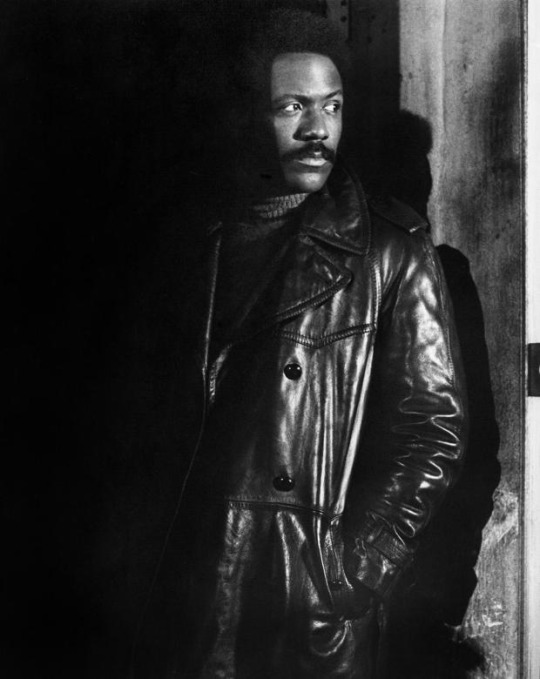
As the star of the trailblazing 1971 action movie "Shaft," Richard Roundtree (July 9, 1942-October 24, 2023)
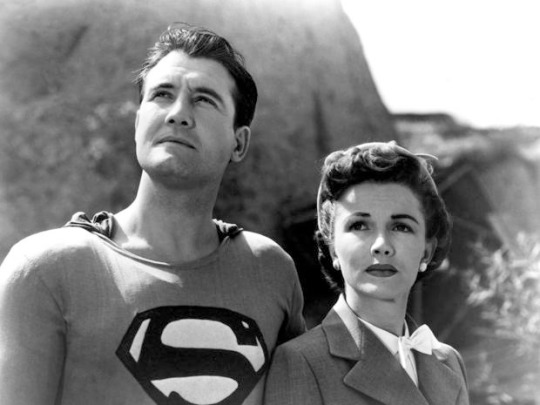
Actress Phyllis Coates (January 15, 1927-October 11, 2023) "Adventures of Superman."

Character actor Burt Young (April 30, 1940-October 8, 2023)

Irish-English actor Sir Michael Gambon (October 19, 1940-September 27, 2023)
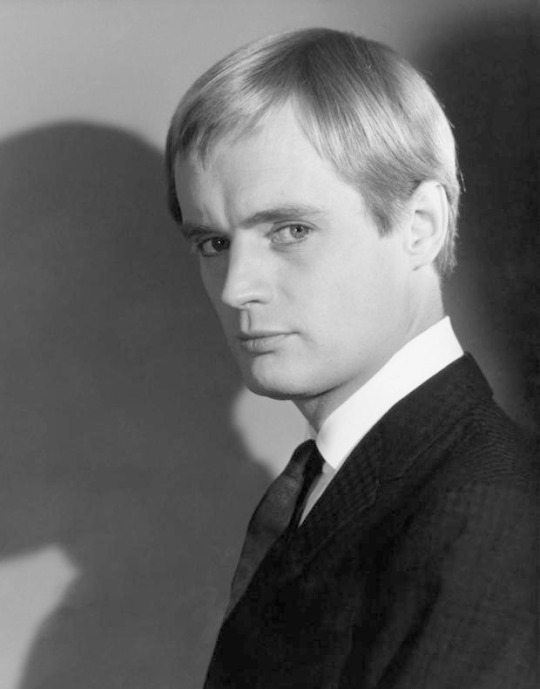
Actor David McCallum (September 19, 1933-September 25, 2023)

The songs of Jimmy Buffett (December 25, 1946-September 1, 2023)

Singer Tina Turner (November 26, 1939-May 24, 2023)

Canadian singer-songwriter Gordon Lightfoot (November 17, 1938-May 1, 2023)
. . . And MANY More...I just couldn't post ALL of them.
NOTHING Last Forever...! (Remember That)
29 notes
·
View notes
Text
Two years have passed since Russia launched its full-scale invasion of Ukraine. Russian brutality against Ukrainians has been striking, and the evidence of Russia’s war crimes is mounting as the atrocities continue.
What has become evident is that these war crimes are not aberrations or crimes of omission. They are part and parcel of what Russia is trying to achieve in Ukraine. Testimonies collected by my organization, the Reckoning Project, and by others point to the systematic and deliberate nature of Russia’s crimes.
This makes the pursuit of accountability in Ukraine not only about justice. It is also about denying Russia its objectives and setting a precedent for other states intent on attacking their neighbors. Ensuring accountability and justice in Ukraine will contribute to accountability and justice globally.
Every day, Ukraine’s Office of the Prosecutor General publishes on its website the total number of war crime cases that the office has registered since February 2022. This month, that number passed 125,000. The number—staggering by any account—increases every day, sometimes by the hundreds, and stands for thousands of destroyed lives. Each case is a devastating tragedy in and by itself.
The actual number of war crimes is much higher, as the reported number doesn’t account for most of the crimes committed in the occupied territories, where Ukrainian law enforcement has no access—close to 20 percent of Ukraine. There may be some 3 million Ukrainians still living in these territories. Many residents have fled, but many still remain.
Beyond the scale of the crimes, it’s crucial to understand that the atrocities are integral to Russia’s war aims. Of course, some crimes are the result of a rogue soldier’s actions. But the bulk of crimes stem directly from how and why Russia is waging war against Ukraine. They are a feature, not a bug, of Russia’s war. They are systematic, deliberate, and serve a clear purpose.
Take the missile and drone strikes against civilian critical infrastructure. Last winter, Russia launched a massive air campaign against Ukraine’s energy infrastructure, causing nearly irreparable damage to the energy network. The purpose of these attacks was to make Ukraine uninhabitable during the cold winter. This was intended to trigger a new wave of refugees into the European Union with the aim of creating divisions among Europeans and undermining their support for Ukraine.
Today, the barrages of missile and drone attacks against civilian targets—including schools, shopping malls, and apartment blocks—are meant to terrorize the population in order to undermine Ukrainian’s morale and put pressure on the government in Kyiv to capitulate.
Russia’s crimes can also be seen in the liberated territories. The scale and scope of these crimes became evident when Ukrainian forces entered previously occupied towns such as Bucha and Irpin in the early days of the invasion. Mass atrocities were also uncovered in the Kherson and Kharkiv regions after these territories were liberated.
The killing of civilians, torture, and disappearances were part of a deliberate strategy to terrorize the local population and rid the territories of Ukrainian resistance. These crimes were—and are—a deliberate means to subdue and control Ukrainians living under occupation.
When preparing the invasion, Russia developed plans to take over and exercise control over Ukrainian territories. These included filtration camps and death lists of notable activists, journalists, and politicians. Although Russia failed to take Kyiv, these policies are being implemented in the territories it managed to occupy.
As Alice Jill Edwards, the U.N. special rapporteur on torture, wrote in a report in September 2023, Russia’s torture of Ukrainians was “orchestrated as part of a State policy to intimidate, to instil fear, to punish, or to extract information and confessions.”
But these systematic war crimes are not merely about eliminating resistance and subjugating a conquered population to Russian rule. The aim is also to Russify these territories and the Ukrainians living there.
This can be seen in one of the most egregious crimes being committed by Russia: the deportation of Ukrainian children. Kyiv estimates that 20,000 Ukrainian children have been deported to Russia, of which fewer than 400 have been returned to Ukraine. The Reckoning Project and other organizations have documented ample evidence of these deportations.
Ukrainian children are sent to Russia—ostensibly to summer camp—and never returned to their parents. They are taken from orphanages in Ukraine and put in foster homes in Russia. They are separated from their parents in filtration camps. Many of the deported children are adopted by Russians and given Russian identities.
The deportation of children—the war crime on which the International Criminal Court’s arrest warrant for Russian President Vladimir Putin is based—goes to the heart of Russia’s objectives in Ukraine: to destroy Ukrainian identity, culture, and ultimately the nation.
This can also be seen in the systematic indoctrination and reeducation of Ukrainian children living in the occupied territories. Ukrainian children are effectively taught to abandon their Ukrainian identity and instead become loyal Russian subjects.
It is important to understand what Russian occupation means in Ukraine. It is not merely a question of switching the language from Ukrainian to Russian in schools or Ukrainian flags being replaced by Russian flags. Occupation means oppression, torture, disappearances, indoctrination, and kidnapped children. It means the eradication of one’s culture and identity.
Russia’s actions in the occupied territories demonstrably negate the argument that its invasion was sparked by fears that Ukraine would join NATO and pose a security threat to Russia. The aggression was driven by Putin’s imperial ambition of “gathering the Russian lands” by conquering Ukraine. The country’s possible membership in NATO or the EU was seen as an obstacle to this ambition rather than a security threat.
Moscow’s efforts to Russify Ukraine and Ukrainians are also why the notion of freezing the conflict and accepting Russian control over the occupied territories is unthinkable for most Ukrainians. Two years into the war, their will to fight remains remarkably high. This is because Ukrainians know what occupation means: the destruction of a large part of their nation. Contrary to many Western armchair strategists, they know that occupation is about people—not just about land.
Holding Russia accountable for its crimes in Ukraine matters first and foremost to the victims and their families. It is primarily about ensuring justice for those who have suffered from Russia’s aggression. But it is also about denying Russia its strategic objectives in Ukraine. The pursuit of accountability puts pressure on the perpetrators and can help deter further crimes. It is a way to push back at Russia’s attempt to terrorize the population, dismember the country, and destroy the nation.
The war in Ukraine is also part of Russia’s wider effort to remodel the rules-based international order. Moscow seeks a world where might makes right, where only strong countries are sovereign, and where disregard for the laws of war is the norm. It seeks a world in which Russia can act with impunity in its neighborhood and beyond.
In that way, the war in Ukraine was enabled by the weak international response to Russia’s past wars in Chechnya, Georgia, and Syria. Just as impunity in Chechnya, Georgia, and Syria enabled Russian crimes in Ukraine, impunity in Ukraine would enable crimes elsewhere.
That Russia, in particular, is the perpetrator matters. As a permanent member of the U.N. Security Council and a nuclear power, it has a direct impact on the fabric of the international system. Accountability in Ukraine will help deter other would-be perpetrators of war crimes, regardless of their international status and standing.
To this end, the arrest warrant against Putin for the deportation of Ukrainian children is particularly powerful. It restricts his ability to engage on the global stage and represent Russia in international relations. The designation as a suspected war criminal will follow him to his grave. Other would-be tyrants are taking note.
14 notes
·
View notes
Text


I want to hire you. My father. He's been murdered... Please. My father...he had many rivals, maybe enemies... Please. I just want to see justice done.
Private investigator Elemmírë has been hired by Lady Findis, the oldest daughter of Lord Finwë Noldoran, to find her father's murderer. As she gets to know the House of Finwë and their associates, the web of lies surrounding each of them seems to stretch further and further. Danger lurks in every corner of Formenos Lodge, not the least of which is the enchanting nature of her client. If she is to prevent further harm to the family—or her own heart—she must solve this case as quickly as she can. Yet with so many suspects and so many motives, where should she even begin?
~
For the @tolkienrsb 2023: a Victorian Murder Mystery AU, starring detective Elemmírë and Lady Findis! Read @lithgaeril's fantastic fic of my art beginning on September 8!
text in the background of the first image reads:
incident occurred at the Noldoran manor in the Formenos countryside. At the scene of the crime [cut off]
The client is one Findis Noldoran, daughter of the victim by his second wife. Suspects include the victim's eldest son, Fëanáro Noldoran, notably obsessive and vindictive to his half-siblings. Fëanáro showed immense grief and instability following his father's death, which could point to a guilt-ridden mind, or a true spiral of grief [cut off]
looking beyond family members, business and political rivals abound as well. Noldoran was popular among his staff but the same cannot be said of Melkor Bauglir, who was last seen on the property on the very day of the murder. This does not preclude his innocence, especially given the rivalry between him and Finwë Noldoran's eldest son, and the [cut off]
(sorry for no image description, i do not have the spoons for that right now)
#trsb#trsb23#trsb2023#tolkienrsb#my edit#tefain nin#edit writing#silm#silmarillion#the silmarillion#silmedit#elemmire#findis#findis x elemmire#elemmire x findis#findimmire#tolkien femslash#finweans#house of finwe#finwe#maedhros#feanor#indis#nerdanel#fingon#victorian murder mystery au#what lies behind the truth?#lithgaeril#murder at formenos
22 notes
·
View notes
Text


SIR MICHAEL GAMBON (1940-Died September 27th 2023,at 82,Pneumonia).Anglo-Irish actor forever remembered by millions of Harry Potter fans as Professor Albus Dumbledore,in the last 6 films of the Harry Potter film franchise.
Gambon started his acting career with Laurence Olivier as one of the original members of the Royal National Theatre. Over his six-decade-long career, he received three Olivier Awards, two Screen Actors Guild Awards, and four BAFTA Awards. In 1998, he was knighted by Queen Elizabeth II for services to drama.
Gambon appeared in many productions of works by William Shakespeare such as Othello, Hamlet, Macbeth and Coriolanus. Gambon was nominated for thirteen Olivier Awards, winning three times for A Chorus of Disapproval (1985), A View from the Bridge (1987), and Man of the Moment (1990). In 1997, Gambon made his Broadway debut in David Hare's Skylight, earning a Tony Award for Best Actor in a Play nomination.
Gambon made his film debut in Othello (1965). Other notable films include The Cook, the Thief, His Wife & Her Lover (1989), The Wings of the Dove (1997), The Insider (1999), Gosford Park (2001), Amazing Grace (2006), The King's Speech (2010), Quartet (2012), and Victoria & Abdul (2017). Gambon also appeared in the Wes Anderson films The Life Aquatic with Steve Zissou (2004), and Fantastic Mr. Fox (2009). Gambon enhanced his stardom through his role of Albus Dumbledore in the Harry Potter film series from 2004 to 2011, replacing Richard Harris following his death in 2002.
For his work on television, he received four BAFTA Awards for The Singing Detective (1986), Wives and Daughters (1999), Longitude (2000), and Perfect Strangers (2001). He also received two Primetime Emmy Award nominations for Path to War (2002) and Emma (2009). Other notable projects include Cranford (2007) and The Casual Vacancy (2015). In 2017, he received the Irish Film & Television Academy Lifetime Achievement Award. In 2020, he was listed at No. 27 on The Irish Times' list of Ireland's greatest film actors.Michael Gambon - Wikipedia
#Sir Michael Gambon#Irish Actors#Anglo Irish Actors#British Actors#Actors#Professor Dumbledore#Albus Dumbledore#Harry Potter#Harry Potter Films#The Singing Detective#The Cook The Thief His Wife and Her Lover#Notable Deaths in September 2023#Notable Deaths in 2023
25 notes
·
View notes
Text
I have a story to tell. Look at me. I need to talk about public transit.
Behold... the woeful tale of the most cursed subway station in the system (content warning bodegaland under the cut)...
I present to you - 191st Street on the 1 Train.
This station is notable for being the deepest underground. It is 173 feet (53 m) below street level. This is because it is under a massive, steep hill in the neighborhood of Ft George. Most of New York City is pretty flat, however, in places like Northern Manhattan and parts of The Bronx, the terrain is quite hilly. This specific hill is notable for being big enough to almost completely cut off the neighborhood of Inwood (northern tip of Manhattan) from the rest of the island.
The station itself has a simple enough layout, a northbound and southbound platform connected by a covered pedestrian footbridge and mezzanine. The atmosphere is what is different - you're so far underground that the air is still and stale, and in between the arrival and departure of trains, it is deathly quiet.

So you're likely thinking, "how does one exit this strange station at the bottom of such a big hill?" There are two ways to enter and leave the station: a set of four large freight-style elevators, or a long pedestrian tunnel which lets out at the bottom of the hill. There are no stairs.
Let's talk about the elevators first, should you decide to brave them. Luckily for you, they've recently been completely replaced! This is a wonderful thing, because the old ones were absolutely slow and rickety as hell and would often stall out and return to the bottom of the station when overloaded (being overloaded, mind you, by exhausted and nervous commuters eager to make it out of there).
Here is a video shot by a transit enthusiast riding the old elevators shortly before replacement. Note how it took a full 43 seconds to make the ascent, and that is with only one person riding in it! He also made a follow-up video riding the new elevators, which ascend at a crisp 34 seconds.
Now you might be thinking, "those elevators seem like a total death trap. What about the tunnel?" Well...
The tunnel is made of concrete, dimly lit, and 900 feet (270 meters) long. For a years, the walls were covered in graffiti art and murals commissioned by the NYC Department of Transportation. To be fair, it looked pretty cool!


However, I'm sure you noticed the past tense in the preceding paragraph. In January 2023, DOT completely painted over the tunnel in an unflattering shade of landlord white. It looked like this:

Understandably the community was quite upset by this. DOT eventually began commissioning artists to beautify the tunnel in September 2023:

Certainly an improvement! The tunnel still lets out at the bottom of the hill though, so I hope that you don't have business at the top of the hill. It's also a long walk from one end to the other, and the thick concrete walls make the sounds inside very isolated. Not ideal for any semblance of safety.
In conclusion, this post may make 191st Street interesting, but I still suggest avoiding it. The atmosphere in this station is oppressive and eerie, the elevators and tunnel out are of dubious safety, and there isn't much to see or do here if you don't live in the immediate neighborhood.
New york fuckin city babey!!!!!!!!!
#woe! american public transit be upon ye!#our transit system is over a century old and falling apart at the seams#and it's only going to get worse with climate change 😎#transit talk
8 notes
·
View notes
Text
Who Were The Tarim Basin Mummies? Even Scientists Were Surprised. The Enigmatic, Extremely Well-preserved Mummies Still Defy Explanation—and Draw Controversy.
— By Erin Blakemore | September 15, 2023

Hundreds of bodies have been excavated from cemeteries like this one around the Tarim Basin in Xinjiang, a region of Western China. Known as the Tarim Basin mummies, these people lived some 4,000 years ago—and their ancient DNA has yielded surprising insights. Photograph By Wenying LI, XinJiang Institute of Cultural Relics And Archaeology
Though they died thousands of years ago, hundreds of bodies excavated in East Asia’s Tarim Basin look remarkably alive. They retain the hairstyles, clothing, and accoutrements of a long-past culture—one that once seemed to suggest they were migrant Indo-Europeans who settled in what is now China thousands of years ago.
But the mummies’ seemingly perfect state of preservation wasn’t their only surprise. When modern DNA research revealed the preserved bodies were people indigenous to the Tarim Basin—yet genetically distinct from other nearby populations—the Tarim Basin mummies became even more enigmatic. Today, researchers still ask questions about their cultural practices, their daily lives, and their role in the spread of modern humanity across the globe.
How Were The Tarim Basin Mummies Found?
Buried in a variety of cemeteries around the basin as long as 4,000 years ago, the naturally mummified corpses were first unearthed by European explorers in the early 20th century. Over time, more and more of the Tarim bodies were unearthed, along with their spectacular cultural relics. To date, hundreds have been found. The earliest of the mummies are about 2,100 years old, while more recent mummies have been dated to about 500 B.C.

One of the most famous mummies found in the Tarim Basin is the Princess of Xiaohe, also known as the Beauty of Xiaohe. Named for the cemetery where her body was found, she is remarkably well-preserved even down to her eyelashes. Photograph By Wenying LI, XinJiang Institute of Cultural Relics And Archaeology
Who Really Were The Tarim Basin Mummies?
At first, the mummies’ Western-like attire and European-like appearance prompted hypotheses that they were the remains of an Indo-European group of migrant people with roots in Europe, perhaps related to Bronze-Age herders from Siberia or farmers in what is now Iran.
They had blond, brown, and red hair, large noses, and wore bright, sometimes elaborate clothing fashioned from wool, furs, or cowhide. Some wore pointed, witch-like hats and some of the clothing was made of felted or woven cloth, suggesting ties to Western European culture.
Still others wore plaid reminiscent of the Celts—perhaps most notably one of the mummies known as Chärchän Man, who stood over six feet tall, had red hair and a full beard, and was buried over a thousand years ago in a tartan skirt.
Another of the most famous of the bodies is that of the so-called “Princess” or “Beauty” of Xiaohe, a 3,800-year-old woman with light hair, high cheekbones, and long, still-preserved eyelashes who seems to be smiling in death. Though she wore a large felt hat and fine clothing and even jewelry in death, it is unclear what position she may have occupied in her society.
But the 2021 study of 13 of the mummies’ ancient DNA led to the current consensus that they belonged to an isolated group that lived throughout the now desert-like region during the Bronze Age, adopting their neighbors’ farming practices but remaining distinct in culture and genetics.
Scientists concluded that the mummies were descendants of Ancient North Eurasians, a relatively small group of ancient hunter-gatherers who migrated to Central Asia from West Asia and who have genetic links to modern Europeans and Native Americans.
How Were They Mummified?
These bodies were not mummified intentionally as part of any burial ritual. Rather, the dry, salty environment of the Tarim Basin—which contains the Taklimakan Desert, one of the world’s largest—allowed the bodies to decay slowly, and sometimes minimally. The extreme winter cold of the area is also thought to have helped along their preservation.
How Were They Buried?
Many bodies were interred in “boat-shaped wooden coffins covered with cattle hides and marked by timber poles or oars,” according to researchers. The discovery of the herb ephedra in the burial sites suggests it had either a medical or religious significance—but what that religion might have been, or why some burials involve concentric rings of wooden stakes, is still unclear.

Mummified corpses were first unearthed in the Tarim Basin by European explorers in the early 20th century. Their Western-like appearance and clothing originally led researchers to believe these ancient people were migrants from Europe—but DNA later debunked that theory. Photograph By Wenying LI, XinJiang Institute of Cultural Relics And Archaeology
What Did They Eat?
Masks, twigs, possibly phallic objects, and animal bones found at the mummies’ cemeteries provide a tantalizing view of their daily lives and rituals. Though most questions about their culture remain unanswered, the burials did point to their diets and the fact that they were farmers. The mummies were interred with barley, millet, and wheat, even necklaces featuring the oldest cheese ever found. This indicates that they not only farmed, but raised ruminant animals.
What Were Their Daily Lives Like?
The Tarim Basin dwellers were genetically distinct. But their practices, from burial to cheesemaking, and their clothing, which reflects techniques and artistry practiced in far-off places at the time, seem to show they mixed with, and learned from, other cultures, adopting their practices over time and incorporating them into a distinct civilization.
Researchers now believe their daily lives involved everything from farming ruminant animals to metalworking and basketmaking—helped along by the fact that the now-desolate desert of the Tarim Basin region was once much greener and had abundant freshwater.
Researchers also believe that the Tarim Basin residents traded and interacted with other people in what would eventually become a critical corridor on the Silk Road, linking East and West in the arid desert.
But archaeologists still have much to learn about what daily life was like for these ancient humans, including who they traded with, what religious beliefs they adopted, and whether their society was socially stratified.

Most of the bodies were found buried in boat-shaped coffins like this one, with the site typically marked by oars. This coffin is covered with a cattle hide, suggesting that the Tarim Basin people raised cattle and other ruminant animals. Photograph By Wenying LI, XinJiang Institute of Cultural Relics And Archaeology
Why Are The Tarim Basin Mummies Controversial?
The amazingly preserved mummies have long fascinated archaeologists. But the Tarim Basin mummies have also become political flashpoints. The Tarim Basin is located in the modern-day Xinjiang Uyghur Autonomous Region, land claimed by China’s Uyghur minority. Uyghur nationalists claim the mummies are their forbears, but the Chinese government refutes this and has been reluctant to allow scientists to study the mummies or look at their ancient DNA.
In 2011, China withdrew a group of the mummies from a traveling exhibition, claiming they were too fragile to transport. Some research about the mummies’ DNA has been criticized as downplaying the region’s distinctness in support of China’s attempts to assimilate Uyghur people. Just as more remains to be learned about the enigmatic mummies, their future as political and national symbols remains disputed too.
#History & Culture#Tarim Basin | Mummies#Scientists#Enigmatic | Extremely Well-Preserved Mummies | Defy Explanation#Draw Controversy#Xinjiang | China 🇨🇳#East Asia’s Tarim Basin#Western China 🇨🇳#Buried | 4000-Year-Old#Naturally Mummified Corpses | 20th Century | European Explorers#Mummies | Western-Like Attire | European-Like Appearance#Bronze-Age Herders | Siberia Russia 🇷🇺 | Farners in Iran 🇮🇷#Western European Culture#Celts#Chärchän Man#Princess | Beauty | Xiaohe#Central Asia | West Asia#Modern Europeans | Native Americans#Boat-Shaped Wooden Coffins | Covered | Cattle Hides | Marked | Timber Poles or Oars#Barley | Millet | Wheat 🌾 | Necklaces | Oldest Cheese 🧀#Silk Road | Linked | East and West | Arid Desert 🌵#Tarim Basin | Modern-Day Xinjiang | Uyghur Autonomous Region
16 notes
·
View notes
Text

Press Release
Harvard Art Museums’ Fall 2023 Exhibition Explores
Entwined Histories of the Opium Trade and the Chinese

Art Market
Opium pipe, China, Qing dynasty to Republican period, inscribed with cyclical date corresponding to 1868 or 1928. Water buffalo horn, metal, and ceramic. Harvard Art Museums/Arthur M. Sackler Museum, Bequest of Grenville L. Winthrop, 1943.55.6.
Cambridge, MA
This fall, the Harvard Art Museums present an exhibition that explores the entangled histories of the western sale of opium in China in the 19th century and the growing appetite for Chinese art in the United States at the beginning of the 20th century. Opium and Chinese art—acquired through both legal and illicit means—had profound effects on the global economy, cultural landscape, and education, and in the case of opium on public health and immigration, that still reverberate today. Objects of Addiction: Opium, Empire, and the Chinese Art Trade, on display September 15, 2023 through January 14, 2024 in the Special Exhibitions Gallery on Level 3 of the Harvard Art Museums, looks critically at the history of Massachusetts opium merchants and collectors of Chinese art, as well as the current opioid crisis.
A range of accompanying public programs will encourage community discussion around related topics, including the state of the opioid crisis in New England, the lingering political and economic effects of the Opium Wars, opium’s role in anti-Chinese U.S. immigration laws, and Chinese art collecting in Massachusetts. In addition, the artist collective 2nd Act will present a series of drama therapy workshops challenging ideas about addiction, and the Cambridge Public Health Department and Somerville Health and Human Services will host trainings on the use of naloxone (Narcan) to reverse opioid overdoses. In the early planning stages, Sarah Laursen, the Alan J. Dworsky Associate Curator of Chinese Art at the Harvard Art Museums, worked with Harvard students Emily Axelsen (Class of 2023), Allison Chang (Class of 2023), and Madison Stein (Class of 2024), who were instrumental in the development of the exhibition’s narrative and associated programming. Laursen also held a series of community feedback sessions to solicit reactions to the show’s content from Harvard students, faculty, and staff, as well as local experts and community members. Notably, the exhibition is opening during National Recovery Month, a national observance held each September to educate Americans about substance use disorder and the treatment options and services that can enable them to live healthy and rewarding lives.
“This exhibition is about the past and its impact on the present—but my hope it that it will also help us to think more productively about the future,” said Laursen.
“For example, the stigma around opium use initially resulted in the Qing government imposing harsh punishments for people experiencing addiction, rather than offering the empathy, treatment, and resources that people needed. Today, with overdose death rates in Massachusetts topping 2,300 individuals per year, we can learn from the past and choose to adopt harm reduction measures that will save lives.” On the collecting of Chinese art, Laursen notes, “By reexamining the formation of early 20th-century museum collections—as well as the underrecognized consequences of these initial acquisitions—we become better equipped to shape our policies for ethical collecting in the future.”
The exhibition comprises three thematic sections and presents more than 100 objects, including paintings, prints, Buddhist sculptures and murals, ceramics, jades, and bronzes, as well as historical materials including books, sale and exhibition catalogues, and magazine clippings from the collections of the Harvard Art Museums, with loans generously provided by the Peabody Museum of Archaeology and Ethnology, Fine Arts Library, Harvard-Yenching Library, Economic Botany Library of Oakes Ames, Houghton Library, and Baker Library (all at Harvard), as well as by the Forbes House Museum, the Ipswich Museum, and Mr. and Mrs. James E. Breece III.
Beginning with an examination of the origins of the opium trade, the first section includes a large comparative timeline that lays out events in China, Europe, and the United States in order to contextualize the complex histories of the opium and Chinese art trades. Britain began illegally selling Indian opium in China in the 18th century and increased its exports to counteract the demand for Chinese tea imports in Europe and the United States. In the 19th century, prominent Massachusett merchants such as members of the Perkins, Forbes, Heard, Cushing, Sturgis, Cabot, Delano, Weld, Peabody, and other elite local families were deeply involved in the lucrative Turkish opium trade as well. Conflicts between the Qing dynasty (1644–1911) and western powers over trading rights led to two Opium Wars (1839–42 and 1856–60), whose outcomes had far-reaching political and economic consequences.
In this first gallery, examples of typical Chinese export wares including tea wares, porcelains, and paintings that were popular in Europe and North America are presented alongside opium-related objects, including an opium pipe made of water buffalo horn and an opium account book for the year 1831 that lays bare the volume of the drug imported into the port of Guangzhou by just one firm, Russell & Co., run initially by members of Forbes family. A Qing dynasty painting of the Port of Shanghai (c. 1863–64), which became a commercial center after the first Opium War, shows a bustling harbor filled with boats and ships and reveals the location of the offices of prominent opium traders such as Russell & Co. and Augustine Heard & Co. Also visible is the headquarters of auctioneer Hiram Fogg, the brother of the China trader William Hayes Fogg, for whom Harvard’s Fogg Museum is named. Along with commerce, the first gallery also presents a range of documentary materials and ephemera that demonstrate the devastating impact of opium on Chinese society. Photographs and mass media illustrations critique the use and sale of opium. A slideshow, In Their Own Words, presents quotations from a diverse range of voices of individuals who were involved in or opposed the sale of opium and collecting of Chinese art. In many cases, these quotes flesh out the perspectives of historical figures who are named in labels throughout the galleries. Audio wands available in this space play excerpts from “Opium Talk,” an essay by Zhang Changjia (Shanghai, 1878) translated by Keith McMahon in The Fall of the God of Money: Opium Smoking in Nineteenth-Century China (Rowman & Littlefield, 2002).
The translations are read by Thomas Ho, a member of the local Chinese American community, and a transcript is available in the gallery, printed with permission from McMahon.
The second section highlights the history of imperial art collecting within China and demonstrates the growing appetite for Chinese art in Europe and the United States after the Opium Wars, especially after the looting of the Old Summer Palace in Beijing by British and French Troops in 1860 and in the wake of the Boxer Rebellion (1899–1901). Through the histories of merchants, collectors, dealers, museum directors, and professors, this section examines the early 20th-century formation of Chinese art collections in Massachusetts, including at the Fogg Museum. Chinese works from the collections of the Forbes House Museum and Ipswich Museum—once homes of opium traders of the Forbes and Heard families—show the taste at this time predominantly for functional or decorative objects such as export ceramics, lacquer furnishings, and other curiosities. However, the flood of newly available palace treasures and archaeological materials prompted the collecting of ancient bronzes and jades unearthed from tombs and Buddhist sculptures chiseled from cave temple walls.
Well-connected dealers in Asian art such as C. T. Loo (or Loo Ching-tsai) and Sadajirō Yamanaka 山中定次郎 acquired items from several sources—including from Chinese elites who fled the country after the fall of the Qing dynasty, imperial family members, and American collectors who lost their fortunes in the Depression—and sold those works to eager collectors around the world, such as Harvard alumnus Grenville L. Winthrop, who obtained 25 fragments from Buddhist cave temples in Tianlongshan, China.
The exhibition includes one work from this group, a sixth-century carved fragment depicting Bodhisattva Manjusri (Wenshu Pusa); to learn more about the Tianlongshan fragments now in the museums’ collections, visit hvrd.art/reframingtianlongshan. Others such as Langdon Warner, a Harvard alumnus and curator at the Fogg Museum, joined the First Fogg Expedition to China (1923–24) and personally removed works from the Mogao Caves in Dunhuang, leaving permanent scars on the archaeological landscape of China. Two wall painting fragments, among the best preserved of the twelve that Warner brought back to Harvard, are displayed alongside a large-sale photograph showing the present condition of the mural from which they were removed (Bust of an attendant bodhisattva and Bust of a bodhisattva surrounded by a monk and devas).
Exhibition curator Sarah Laursen added: “I am often asked, where did this object come from? How did it come to Harvard? In many cases, we do not know their precise sources nor the circumstances of their removal because in the past there was no demand for documentation. For most U.S. collections of Asian art it is rarely possible to reconstruct the complete chain of ownership. But there are some questions we can start to answer: How can we work with source countries to better document, care for, and understand these objects? How can we curtail the black market? What could ethical collecting or sharing of cultural property look like in the future?”
A third section, entitled Opioids Then and Now, investigates parallels between China’s opium crisis and the opioid epidemic in Massachusetts today. Materials here clarify how addiction affects the brain (an animated video, produced for a free online Harvard edX course, plays on a monitor) and offer potentially life-saving information about harm reduction and overdose prevention. Visitors are invited to share their thoughts and personal experiences on response cards in this space and can either post them publicly on a bulletin board in the gallery or deposit them in a private box to be preserved in the Harvard Art Museums Archives. Visitors will also be able to browse recent books about opioids and harm reduction.
A 24-page printed booklet available in the galleries draws together the exhibition’s extensive content in three thematic essays: Who has benefited from the opium trade? Who has been harmed by opium?
What is the legacy of the opium trade in U.S. museums?
None of the works in the exhibition or in the Harvard Art Museums collections as a whole were collected or gifted by Arthur M. Sackler, nor were they purchased using funds provided by him.
Online Resource
Exhibition webpage: harvardartmuseums.org/objectsofaddiction
Public Programming
A range of public programs held in conjunction with the exhibition Objects of Addiction will encourage community discussion around the opioid crisis, the effects of the Opium Wars on U.S.–China relations, the role of opium in Chinese exclusion in the United States, and art collecting practices. Unless noted, all events are held in-person at the Harvard Art Museums, 32 Quincy Street, Cambridge, MA 02138.
Admission to visit our galleries is free, but some programs have a fee (noted below). For updates, full details, and to register, please click the links below or see our calendar:
harvardartmuseums.org/calendar. Questions? Call 617-495-9400.
Lecture — Objects of Addiction: Opium, Empire, and the Chinese Art Trade
Thursday, September 14, 2023, 6–7:30pm
Join curator Sarah Laursen for a lecture on opium and Chinese art—two influential commodities traded in China, the British Empire, and Massachusetts between the 18th and early 20th centuries.
Free admission, but seating is limited and available on a first-come, first-served basis. Following the lecture, guests are invited to visit the exhibition on Level 3. This lecture will be recorded and made available for online viewing; check the link above after the event for the link to view.
Workshops — Rethinking Addiction: A Drama Therapy Workshop with 2nd Act Artist Collective
Saturday, September 16, 2023, 2–4pm
Sunday, October 22, 2023, 2–4pm
Saturday, November 11, 2023, 2–4pm
Drama therapists Ana Bess Moyer Bell and Amy Lazier of the artist collective 2nd Act will lead workshops designed to challenge participants’ ideas about addiction through a drama therapy model. By examining, embodying, and de-stigmatizing addiction and creating metaphorical objects of care, love, and support, participants will develop a shared understanding of addiction and how it affects daily life. $15 materials fee. Registration is required and space is limited. Minimum age of 14; no previous experience required.
Lecture — Objects of Addiction: Perspectives on the Opioid Crisis in New England
Sunday, September 24, 2023, 2–3:30pm
Specialists in addiction medicine, harm reduction, and public health policy will take part in a roundtable discussion about the current state of the opioid crisis in New England. Speakers:
Danielle McPeak, Prevention and Recovery Specialist, Cambridge Public Health Department; Leo Beletsky, Professor of Law and Health Sciences; Faculty Director, The Action Lab at the Center for Health Policy and Law, Northeastern University; Mark Joseph Albanese, Assistant Professor of Psychiatry, Harvard Medical School; Medical Director, Physician Health Programs; former Medical Director for Addictions, Cambridge Health Alliance; Bertha Madras, Professor of Psychobiology, Harvard Medical School; Director, Laboratory of Addiction Neurobiology, and Psychobiologist,
Division of Basic Neuroscience, McLean Hospital; Jay Garg ’24, Policy Chair for HCOPES
(Harvard College Overdose Prevention and Education Students); and Dennis Bailer, Overdose Prevention Program Director, Project Weber/RENEW. Free admission, but seating is limited and available on a first-come, first-served basis. Before and after the discussion, guests are invited to visit the exhibition on Level 3.
Gallery Talks — Objects of Addiction: Opium, Empire, and the Chinese Art Trade
Tuesday, October 3, 2023, 12:30–1pm
Wednesday, October 18, 2023, 12:30–1pm
Thursday, November 16, 2023, 12:30–1pm
Friday, December 1, 2023, 12:30–1pm
Wednesday, December 13, 2023, 12:30–1pm
Join curator Sarah Laursen for thematic 30-minute talks focused on select artworks in the exhibition. Free admission, but space is limited to 18 people and registration is required.
Narcan Trainings with the Cambridge Public Health Department and Somerville Health and Human Services
Tuesday, October 17, 2023, 5:30–6:30pm
Sunday, November 19, 2023, 2–3pm
Friday, December 1, 2023 (time TBA)
With an abundance of care for our community, the Harvard Art Museums are hosting one-hour on-site Narcan trainings, facilitated by the Cambridge Public Health Department and Somerville Health and Human Services. Their staff will also distribute the medicine for attendees to take home.
Naloxone (also known as Narcan) is a nasal spray that can rapidly reverse an opioid overdose by blocking opioids from attaching to receptors in the brain. Free admission, but space is limited and registration is required.
Exhibition Tours — Objects of Addiction: Opium, Empire, and the Chinese Art Trade
Thursday, October 26, 2023, 12–1pm
Tuesday, November 21, 2023, 12–1pm
Saturday, December 9, 2023, 12–1pm
Join curator Sarah Laursen for hourlong tours of the exhibition. Free admission, but space is limited to 18 people and registration is required.
Online Lecture — Objects of Addiction: A Conversation about Opium and Anti-Chinese Immigration
Laws in the United States
Saturday, October 28, 2023, 10–11am
Award-winning author and Harvard history professor Erika Lee will be in conversation with two Harvard students about the role of opium in the restrictions on Chinese immigration in the United States in the 19th and 20th centuries. Speakers: Erika Lee, Bae Family Professor of History, Harvard University; Jolin Chan ’25, Harvard University; Student Board Member, Harvard Art
Museums; Madison Stein ’24, Harvard University. This talk will take place online via Zoom. The event is free and open to all, but registration is required.
Lecture — Objects of Addiction: The Legacy of the Opium Wars
Wednesday, November 8, 2023, 6–7:30pm
Harvard faculty in Chinese history, business, politics, and law will take part in a roundtable discussion on the 19th-century Opium Wars and the legacy of the opium trade in U.S.–China relations. Speakers: Mark C. Elliott, Vice Provost for International Affairs; Mark Schwartz Professor of Chinese and Inner Asian History, Harvard University; William C. Kirby, T. M. Chang Professor of China Studies, Harvard University; Spangler Family Professor of Business Administration, Harvard Business School; Rana Mitter, S. T. Lee Professor of U.S.–Asia Relations, Harvard Kennedy School; Meg Rithmire, F. Warren McFarlan Associate Professor of Business Administration, Harvard Business School; Mark Wu, Director of the Fairbank Center for Chinese Studies, Harvard University; Henry L. Stimson Professor of Law, Harvard Law School. Free admission, but seating is limited and available on a first-come, first-served basis.
Lecture — Objects of Addiction: Collecting Chinese Art—Past, Present, and Future
Saturday, November 18, 2023, 2–3:30pm
Curators and specialists will explore early collecting of Chinese art in Massachusetts, historical interpretations of cultural heritage, and how contemporary museum collecting practices have changed and will continue to change in the future. Moderator: Soyoung Lee, Landon and Lavinia Clay Chief Curator, Harvard Art Museums. Speakers: Nancy Berliner, Wu Tung Senior Curator of Chinese Art, Museum of Fine Arts, Boston; Amy Brauer, Curator of the Collection, Division of Asian and Mediterranean Art, Harvard Art Museums; Sarah Laursen, Alan J. Dworsky Associate Curator of Chinese Art, Harvard Art Museums; Lisong Liu, Professor of History, Massachusetts College of Art and Design. Free admission, but seating is limited and available on a first-come, first- served basis. Before and after the lecture, guests are invited to visit the exhibition on Level 3.
Credits
Support for Objects of Addiction: Opium, Empire, and the Chinese Art Trade is provided by the
Alexander S., Robert L., and Bruce A. Beal Exhibition Fund; the Robert H. Ellsworth Bequest to the
Harvard Art Museums; the Harvard Art Museums’ Leopold (Harvard M.B.A. ’64) and Jane Swergold
Asian Art Exhibitions and Publications Fund and an additional gift from Leopold and Jane Swergold; the José Soriano Fund; the Anthony and Celeste Meier Exhibitions Fund; the Gurel Student Exhibition Fund; the Asian Art Discretionary Fund; the Chinese Art Discretionary Fund; and the Rabb Family Exhibitions Fund. Related programming is supported by the M. Victor Leventritt Lecture Series Endowment Fund. The accompanying booklet was made possible by generous support from Mr. and Mrs. James E. Breece III. Additional support for this project is provided by the Dunhuang Foundation.
About the Harvard Art Museums The Harvard Art Museums house one of the largest and most renowned art collections in the United States, comprising three museums (the Fogg, Busch-Reisinger, and Arthur M. Sackler Museums) and three research centers (the Straus Center for Conservation and Technical Studies, the Harvard Art Museums Archives, and the Archaeological Exploration of Sardis). The Fogg Museum includes Western art from the Middle Ages to the present; the Busch-Reisinger Museum, unique among North American museums, is dedicated to the study of all modes and periods of art from central and northern Europe, with an emphasis on German-speaking countries; and the Arthur M. Sackler Museum is focused on art from Asia, the Middle East, and the Mediterranean. Together, the collections include over 255,000 objects in all media. The Harvard Art Museums are distinguished by the range and depth of their collections, their groundbreaking exhibitions, and the original research of their staff. Integral to
Harvard University and the wider community, the museums and research centers serve as resources for students, scholars, and the public. For more than a century they have been the nation’s premier training ground for museum professionals and are renowned for their seminal role in developing the discipline of art history in the United States. The Harvard Art Museums have a rich tradition of considering the history of objects as an integral part of the teaching and study of art history, focusing on conservation and preservation concerns as well as technical studies. harvardartmuseums.org
The Harvard Art Museums receive support from the Massachusetts Cultural Council.
Hours and Admission
Open Tuesday–Sunday, 10am–5pm; closed Mondays and major holidays. Admission is free to all visitors. For further information about visiting, including general policies, see harvardartmuseums.org/visit.
For more information, please contact
Jennifer Aubin
Public Relations Manager
Harvard Art Museums
617-496-5331
6 notes
·
View notes
Text
Heart of Stone (2023)

It isn’t so much that Heart of Stone is bad; it’s that it doesn’t do anything good enough to stand out. This is what I think of when someone says “Netflix Top Ten Original”. When it arrives, it feels like everyone’s watching it. A week later, everyone who saw it has already forgotten about it and moved on to the next action spy-thriller with several notable stars in important roles.
Rachel Stone (Gal Gadot) is part of an MI6 field team. What agents Parker (Jamie Dornan), Yang (Jing Lusi) and Bailey (Paul Ready) don’t know is she’s secretly a member of The Charter, an ultra-secret agency dedicated to peacekeeping that operates outside of any government. The Charter uses The Heart, a sophisticated artificial intelligence, to calculate its agents’ odds of success based on every possible factor in real time. The Heart allows the agents to succeed in the most precarious situations and The Charter to hack into any device. When a mysterious hacker named Keya (Alia Bhatt) makes a move against the Charter, Stone has to blow her cover - unaware this is exactly what her opponent was hoping she would do.
I’ll admit that while watching Heart of Stone, I was entertained in a “it’s moving and I want to see what’s coming next” sort of way. Looking back - particularly after writing that synopsis down - this is the store-brand version of your spy-thriller action film. I can remember a death-defying chase down the Italian Alps and the picture’s final confrontation but these scenes are nothing special; they could be in any movie like this. Stone herself is a protagonist we’ve seen a thousand times. Gal Gadot plays the part fine and she handles the stunts with no problem but her character makes no impact. Similarly, The Charter is dull, dull, dull as a secret organization. I can’t think of any movie that’s done exactly what they’re doing, but I swear I’ve seen it before, probably in another movie I forgot soon after it ended.
Heart of Stone sort of feels like the third entry in a franchise that's limping along. It's as if most of the cast are sick of their roles and asking for their characters to be killed off, revealed as traitors or retired, or are the new replacements introduced to help revitalize a fledgling series. Because Stone is at her most interesting when she has to pretend like she can’t handle fieldwork, the film is most engaging at the beginning, when she’s paired up with Bailey, Yang and Parker. About a third of the movie in, they get dropped. Their absence and the focus on Stone should get us all riled up emotionally but we’re just not invested in the characters enough to really care.
On the upside, there are plenty of twists and turns along the way, the stunt work is good, the action well shot and the special effects convincing. While Stone might not be memorable, you do like her. You also like Gal Gadot in the role enough to never feel bored despite the been-there-done-that story and premise. I want to be nice to this movie but too often, it does the obvious or makes a choice that will have you thinking “Couldn’t you have tried something else?” There’s a point towards the end when a villainous character receives a chance at redemption. The movie really wants us to believe they deserve it. Meanwhile, I’m just thinking “What, you didn’t realize the people you were working with were power-hungry madmen when you were setting up a casino where the high-rollers can bet on who will die first in the footage you’ve hacked from the U.S. military? Give me a break.”
Heart of Stone is Mission: Impossible at home. I mean… it is, LITERALLY since you don’t have to go to the theater to see it and it’s about a group of people, led by an action star doing all sorts of action things to save the day from a shadowing organization. It is also figuratively “Mission: Impossible at home”. (September 3, 2023)

#Heart of Stone#movies#films#movie reviews#film reviews#Tom harper#Greg Rucka#Allison Schroeder#Gal Gadot#Jamie Dornan#Alia Bhatt#Sophie Okonedo#Matthis Schweighofer#2023 movies#2023 films
7 notes
·
View notes
Text

Sir Michael John Gambon CBE (/ˈɡæmbɒn/; October 19, 1940 – September 27, 2023) Film, stage and television actor. Gambon started his acting career with Laurence Olivier as one of the original members of the Royal National Theatre. Over his six-decade-long career, he received three Olivier Awards, two Screen Actors Guild Awards, and four BAFTA Awards. In 1998, he was knighted by Queen Elizabeth II for services to drama. Gambon enhanced his stardom through his role of Albus Dumbledore in the Harry Potter film series from 2004 to 2011, replacing Richard Harris following his death in 2002.
For his work on television, he received four BAFTA Awards for The Singing Detective (1986), Wives and Daughters (1999), Longitude (2000), and Perfect Strangers (2001). He also received two Primetime Emmy Award nominations for Path to War (2002) and Emma (2009). Other notable projects include Cranford (2007) and The Casual Vacancy (2015). In 2017, he received the Irish Film & Television Academy Lifetime Achievement Award.
In 1967, he made his television debut in the BBC television adaptation of Much Ado About Nothing as Watchman No. 4. He also appeared in British programmes such as Softly, Softly (1967), and Public Eye (1968). From 1968 to 1970, he featured in the BBC historical series The Borderers as Gavin Kerr. He also had a recurring role in the Canadian series The Challengers (1972). He also appeared in drama anthology series including Play for Today, Play of the Month, and ITV Playhouse.
His craggy looks soon made him into a character actor. For his lead role in Dennis Potter's The Singing Detective (1986) he won his first British Academy Television Award for Best Actor. He starred as detective Inspector Jules Maigret in an ITV adaptation of twelve of Georges Simenon's books. In 1990, he played Jerry in Harold Pinter's Betrayal for BBC Radio 3. In 1991, he starred as Tommy Hanbury in an episode of the ITV series Minder called "Look Who's Coming To Pinner". He also appeared in the BBC serial Wives and Daughters (1999) based on the Victorian novel by the same name by Elizabeth Gaskell. He portrayed Squire Hamley and received his second BAFTA Award nomination and win for Best Actor. (Wikipedia)
IMDB Listing
#Sir Michael Gambon#TV#Obit#Obituary#O2023#The Singing Detective#Wives and Daughters#Longitude#Emma#Cranford#Path to War#Maigret
10 notes
·
View notes
Text
What Defines a Hero?written by CBerzuela
written: september 19, 2023; 21:38
concluded: september 20, 2023; 00:18

We have to stop seeing our heroes flawlessly. They may embody greatness, but that doesn't mean that they are the epitome of perfectness. Our heroes are also humans like us; they make mistakes, they have their own flaws and they are no exception to death. What's extraordinary about them is their notable love for our country along with their reamarkable actions and their undying commitment to protect it, no matter what.
But does a flaw enough to overshadow their greatness and disregard their sacrifices?
General Gregorio Del Pilar is one of our most controversial heroes with lots of conspiracies and misconceptions surrounding his name.
"arogante"
"tuta ni aguinaldo"
"vain"
---as they call him.
While it's true that Goyo's death in Tirad Pass isn't as heroic and valorous as we deemed it to be, does it automatically means that he didn't die for his beloved country?

Contrary to what most people think, Goyo didn't actually die gloriously riding his white horse and bravely shouting encouragements to his soldiers, that's the romanticized version of the Americans. What actually happened is that the general's rashness to discern the enemy and his order for a ceasefire is what gave the americans an opportunity to shoot him, according to the accounts of Vicente Enriquez, his aide-de-camp and Telesforo Carrasco who were with him during the "battle". It's kind of tragic and devastating that he died that way. His life (along with the 52 out of his 60 troop) ended due to a major fault; a consequence to lack of military planning and strategy. It is equally unfortunate that the humiliating disaster at Pasong Tirad became the reason why some or most people perceive him as an incompetent general and an ineffective military leader.
His hands were also tainted with blood, because apparently he tortured and killed the Bernal Brothers who were Luna's aide-de-camp and loyal soldiers under Aguinaldo's command. As Filipino National Artist for Literature, Nick Joaquin put it, he is "Aguinaldo's hatchetman."

All of his dedication and victories seem to be forgotten and overshadowed by his flaws. People may question his integrity as a hero, if he really deserves to be recognized as one. Some might say that he died to protect his "idol" in the form of Aguinaldo and not for the sake of the Philippines. Well, it's not really the case because even before serving Aguinaldo, he's already part of the revolution, doing his part to show his defiance against the Spanish conquerors. He first showed his prowess in the battlefield when he fought on Kakarong De Sili under Maestrong Sebio against the Spanish forces. He was so determined to defeat them that he didn't backed out eventhough Maestrong Sebio had already escaped leaving the battle to the ten of them (including Goyo's brother, Julian.) There, he was hit by a bullet in the forehead that he luckily survived. You see, the AGILA is already capable of great things even before his prestige as a general.
I hope that we don't only think of that disastrous battle in Tirad whenever we hear his name; i hope that we also look back to the Battle of Kakarong De Sili, the raid at Paombong, Battle of Pasong Balite, Battle of Quingua and Battle Of Calumpit. His flaws and shortcomings as a general is not what defines him as a hero. It is his love for the country that makes him a true hero. For the love to our country, always.

10 notes
·
View notes